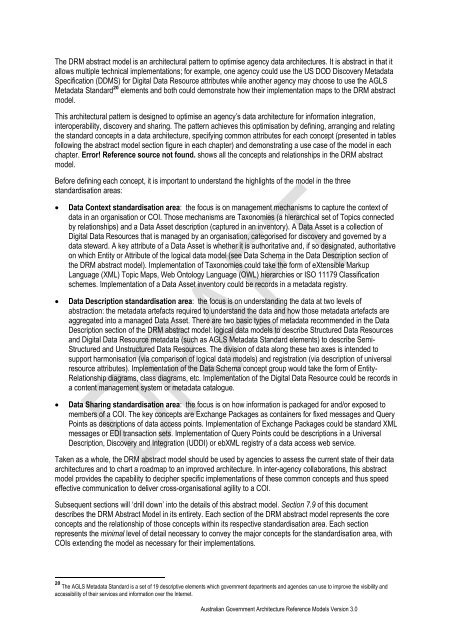Australian Government Architecture Reference Models Version 3.0
Australian Government Architecture Reference Models Version 3.0
Australian Government Architecture Reference Models Version 3.0
You also want an ePaper? Increase the reach of your titles
YUMPU automatically turns print PDFs into web optimized ePapers that Google loves.
The DRM abstract model is an architectural pattern to optimise agency data architectures. It is abstract in that it<br />
allows multiple technical implementations; for example, one agency could use the US DOD Discovery Metadata<br />
Specification (DDMS) for Digital Data Resource attributes while another agency may choose to use the AGLS<br />
Metadata Standard 20 elements and both could demonstrate how their implementation maps to the DRM abstract<br />
model.<br />
This architectural pattern is designed to optimise an agency’s data architecture for information integration,<br />
interoperability, discovery and sharing. The pattern achieves this optimisation by defining, arranging and relating<br />
the standard concepts in a data architecture, specifying common attributes for each concept (presented in tables<br />
following the abstract model section figure in each chapter) and demonstrating a use case of the model in each<br />
chapter. Error! <strong>Reference</strong> source not found. shows all the concepts and relationships in the DRM abstract<br />
model.<br />
Before defining each concept, it is important to understand the highlights of the model in the three<br />
standardisation areas:<br />
� Data Context standardisation area: the focus is on management mechanisms to capture the context of<br />
data in an organisation or COI. Those mechanisms are Taxonomies (a hierarchical set of Topics connected<br />
by relationships) and a Data Asset description (captured in an inventory). A Data Asset is a collection of<br />
Digital Data Resources that is managed by an organisation, categorised for discovery and governed by a<br />
data steward. A key attribute of a Data Asset is whether it is authoritative and, if so designated, authoritative<br />
on which Entity or Attribute of the logical data model (see Data Schema in the Data Description section of<br />
the DRM abstract model). Implementation of Taxonomies could take the form of eXtensible Markup<br />
Language (XML) Topic Maps, Web Ontology Language (OWL) hierarchies or ISO 11179 Classification<br />
schemes. Implementation of a Data Asset inventory could be records in a metadata registry.<br />
� Data Description standardisation area: the focus is on understanding the data at two levels of<br />
abstraction: the metadata artefacts required to understand the data and how those metadata artefacts are<br />
aggregated into a managed Data Asset. There are two basic types of metadata recommended in the Data<br />
Description section of the DRM abstract model: logical data models to describe Structured Data Resources<br />
and Digital Data Resource metadata (such as AGLS Metadata Standard elements) to describe Semi-<br />
Structured and Unstructured Data Resources. The division of data along these two axes is intended to<br />
support harmonisation (via comparison of logical data models) and registration (via description of universal<br />
resource attributes). Implementation of the Data Schema concept group would take the form of Entity-<br />
Relationship diagrams, class diagrams, etc. Implementation of the Digital Data Resource could be records in<br />
a content management system or metadata catalogue.<br />
� Data Sharing standardisation area: the focus is on how information is packaged for and/or exposed to<br />
members of a COI. The key concepts are Exchange Packages as containers for fixed messages and Query<br />
Points as descriptions of data access points. Implementation of Exchange Packages could be standard XML<br />
messages or EDI transaction sets. Implementation of Query Points could be descriptions in a Universal<br />
Description, Discovery and Integration (UDDI) or ebXML registry of a data access web service.<br />
Taken as a whole, the DRM abstract model should be used by agencies to assess the current state of their data<br />
architectures and to chart a roadmap to an improved architecture. In inter-agency collaborations, this abstract<br />
model provides the capability to decipher specific implementations of these common concepts and thus speed<br />
effective communication to deliver cross-organisational agility to a COI.<br />
Subsequent sections will ‘drill down’ into the details of this abstract model. Section 7.9 of this document<br />
describes the DRM Abstract Model in its entirety. Each section of the DRM abstract model represents the core<br />
concepts and the relationship of those concepts within its respective standardisation area. Each section<br />
represents the minimal level of detail necessary to convey the major concepts for the standardisation area, with<br />
COIs extending the model as necessary for their implementations.<br />
20 The AGLS Metadata Standard is a set of 19 descriptive elements which government departments and agencies can use to improve the visibility and<br />
accessibility of their services and information over the Internet.<br />
<strong>Australian</strong> <strong>Government</strong> <strong>Architecture</strong> <strong>Reference</strong> <strong>Models</strong> <strong>Version</strong> <strong>3.0</strong><br />
197

















